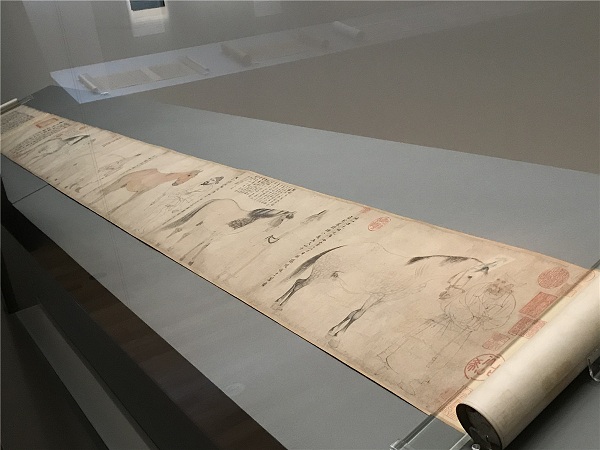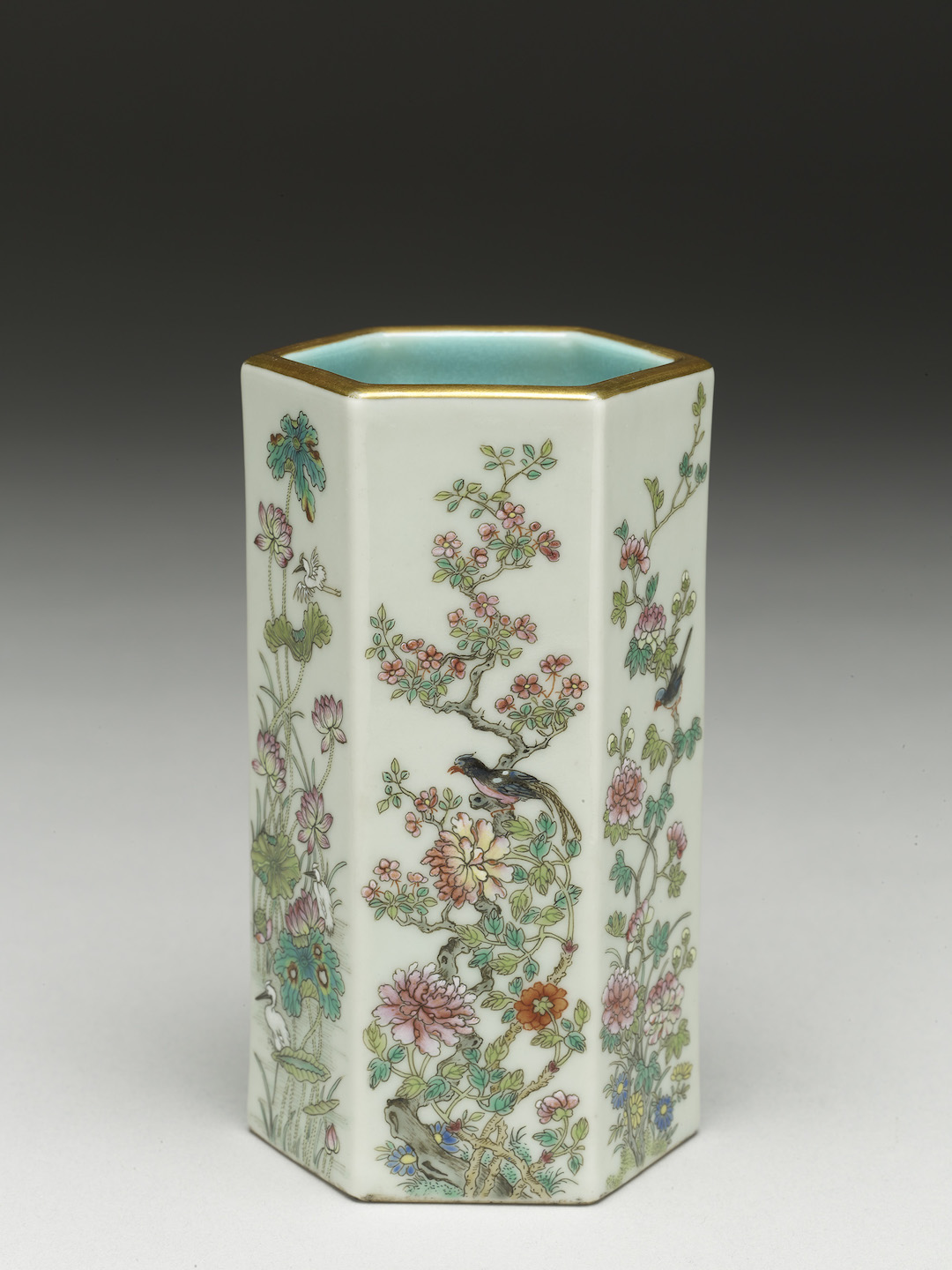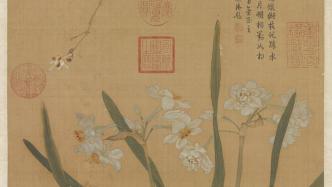
The Paper has learned that "Borderless Ends: Exploring East-West Cultural Exchanges from the Sea in the Sixteenth Century" was recently launched at the National Palace Museum in Taipei. The exhibition brings together calligraphy, paintings, porcelain, documents and other cultural relics from the National Palace Museum in Taipei, China, the Rijksmuseum of the Netherlands, the Musée Guimet in France, and the Osaka Municipal Museum of Oriental Ceramics, to jointly present the story of gathering and exchange through maritime navigation in the 16th century. . The exhibition will last until February 18, 2024.
The 16th century was the era of the "Great Geographic Discovery" in Europe. Navigators traveled across the oceans to explore the unknown world. During this period, mankind achieved global navigation for the first time, and various continents were gradually connected into a whole. The opening of new routes not only brought trade prosperity and cultural exchanges, but also promoted the development of colonialism and imperialism, which had a profound impact on the future world. Complex and far-reaching implications.
The exhibition is divided into three units. "The Age of the Sea" displays nautical charts, silver coins, exported porcelain and other exhibits, leading visitors into the era of maritime hegemony when Europe and Asia met and stirred up each other; "unexpected encounters" with documents, commodities and products "New Diversity" explores the integration of art, knowledge and culture through paintings, calligraphy, utensils, maps and other objects, as well as the concept of "global" that appears to people for the first time.
the age of the sea
In order to find new business opportunities in the market, starting from the late 15th century, European fleets such as Portugal and Spain followed the west coast of Africa, the Cape of Good Hope and the Indian Ocean, as well as the Atlantic, Caribbean, American and Pacific waterways, exploring and establishing strongholds along the way, and then competed to arrive East Asian waters.
The trade order in East Asia was originally centered on the tribute/sea ban system of China's Ming Dynasty, but smuggling trade has also become increasingly active. After the Europeans joined, the maritime ban system became more relaxed, and the Ming Dynasty finally opened the Yuegang of Zhangzhou, Fujian Province in the late 1560s, in response to the changing pulse of the times.
As a result, a large number of commodities, species, and silver circulated around the world for the first time. As a result, people had a new understanding of the sea. In addition to accessing resources and opportunities, they also faced many challenges. The sea has become a channel connecting the land, and a new era of logistics has begun.
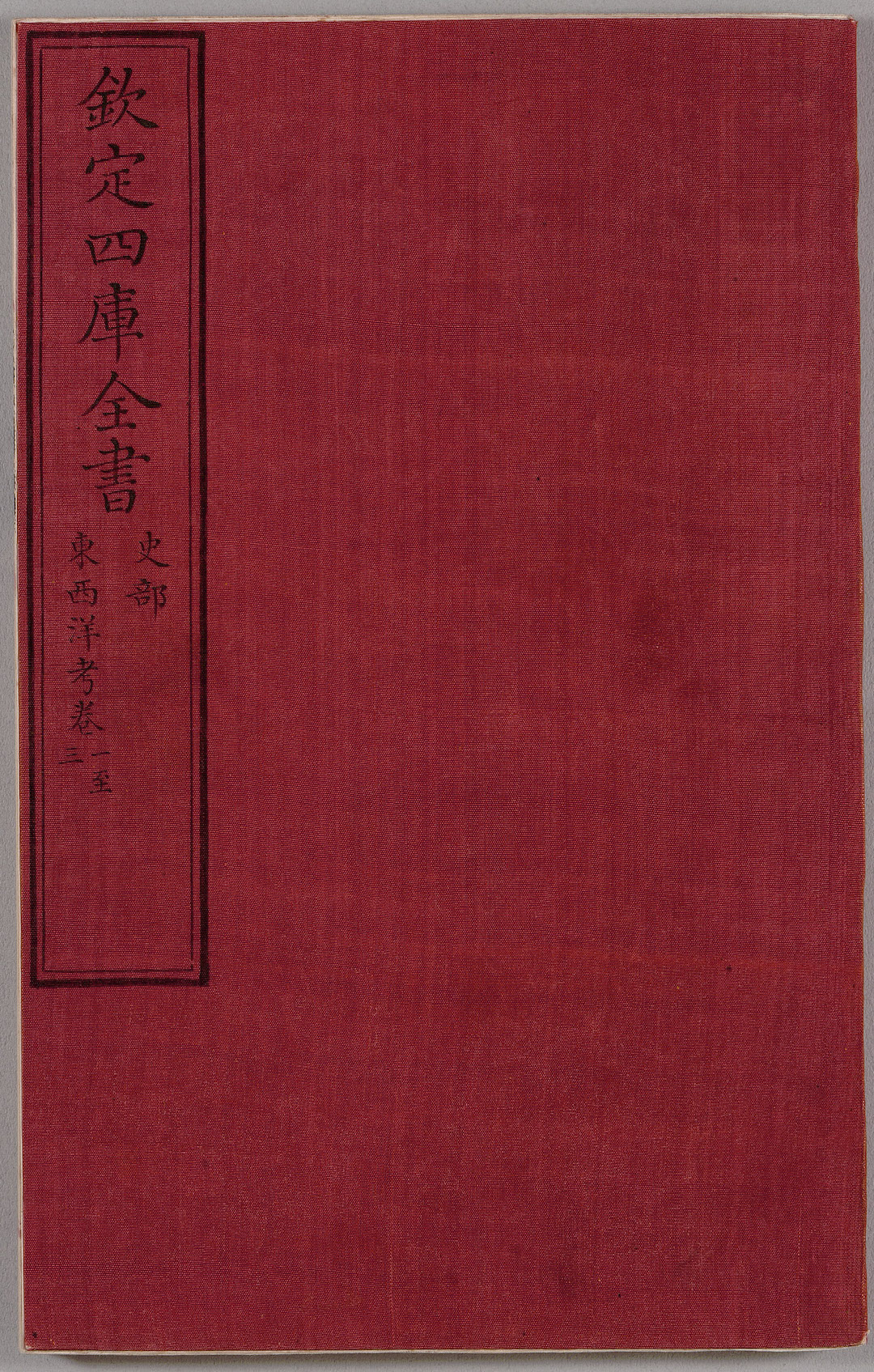
"An Examination of Western and Eastern Oceans" 1617 by Zhang Xie in the Ming Dynasty The complete text of the Siku of Wenyuange during the Qianlong period of the Qing Dynasty
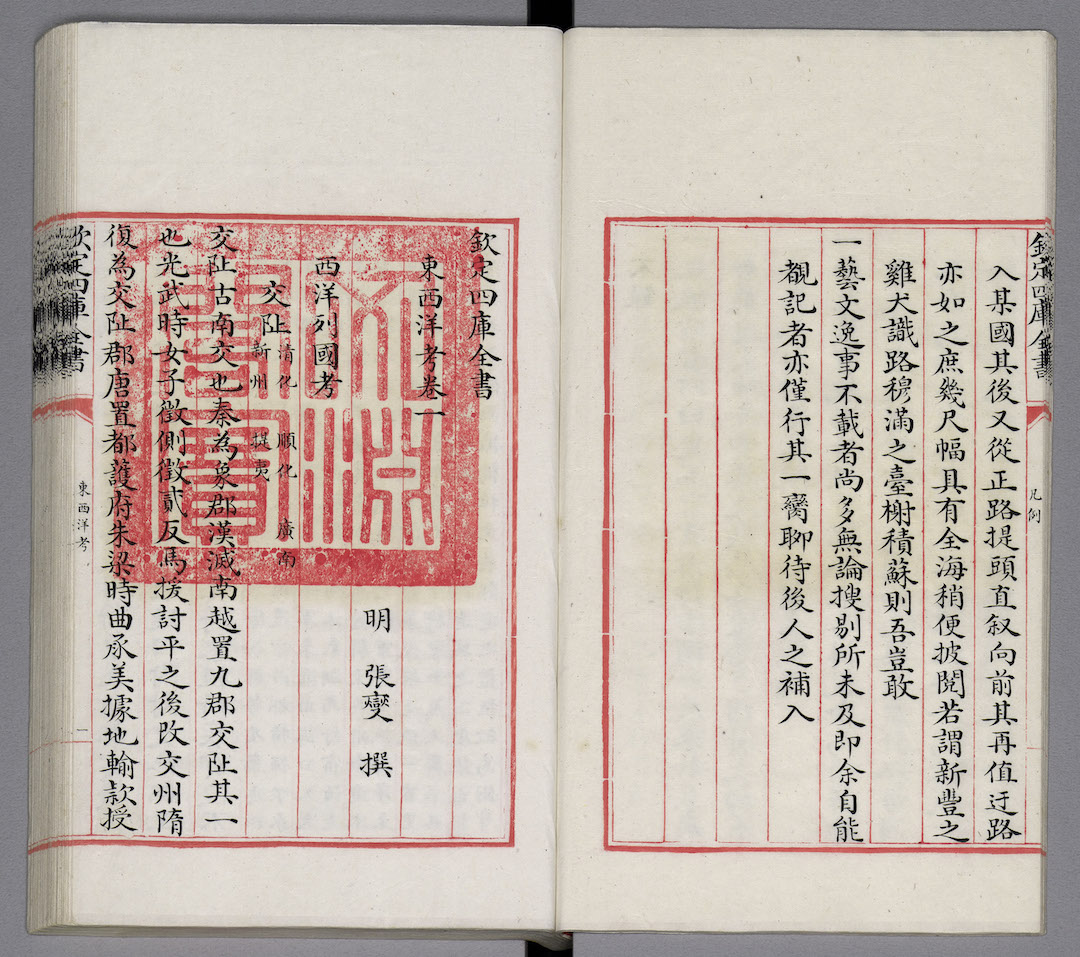
"An Examination of Western and Eastern Oceans" 1617 by Zhang Xie in the Ming Dynasty The complete text of the Siku of Wenyuange during the Qianlong period of the Qing Dynasty
An important maritime document of the Ming Dynasty - "Examination of East and West Oceans", was written in the 45th year of Wanli in the Ming Dynasty (1617). The author, Zhang Xie, whose courtesy name is Shaohe, is from Longxi, Fujian. He signs himself as "History of Haibin". Based on the "Haidao Acupuncture" used by the Ming Dynasty people to navigate the sea, the book integrates the fragments of the old acupuncture into one, and then adds contemporary historical events to provide a comprehensive understanding of the overseas countries that Southeast China came into contact with in the early seventeenth century. A summary of the country's and trade relations is important.
The countries listed in the book are divided into fifteen Western countries and seven Eastern countries. Japan and Hongmao Fan are also listed in the "Waiji Kao". The countries in the two oceans are briefly summarized in history first, and then detailed in three parts: "physical attractions", "products" and "trade". Those listed in Western countries include Jiaozhi, Champa, Siam, Haggang, Cambodia, Dadi, Old Port, Malacca, Yaqi, Pahang, Johor, Ding Jiyi, Sijigang, Wenlang Mashen and Chiman. The geography, history, climate, scenic spots and products of other places are described in detail.

Blue and white pterosaur-shaped military holder, about 1575-1600, collected by the Rijksmuseum of the Netherlands
Junzhi is the transliteration of Sanskrit, which means purification bottle. It was originally a daily necessities in India. In China, the Jingdezhen and Dehua kilns produced the most, and the Shantou kiln (Swatow) also produced them. During the Ming and Qing Dynasties, most of them were exported to Southeast Asia as trading goods. This army holds a slender neck at the mouth of the plate. The neck is in the shape of a goblet, with an oval belly and a flat bottom. It flows into a curved shape like a dragon with its head raised. From the mouth to the neck, it is decorated with four layers of circular triangular geometric patterns, intertwining branch patterns, cloud-filled inlaid lock patterns and inverted banana leaf patterns in sequence from top to bottom. The left and right shoulders are painted with the spread wings of a pterosaur, the abdomen is painted with wave patterns, and the scales of a pterosaur are exposed on the back. Some scholars have pointed out that this work may have had a cover originally, but it has been lost.
This work was made around the late 16th century. Elephants, toads, phoenixes, etc. can also be seen in the military works produced in Jingdezhen during the same period. Examples of elephants and toads holding arms can also be found in the collection of the Temple of Adbil in Iran. Decorative images that combine blue and white pterosaur patterns with wave patterns began to appear in the blue and white works produced in Jingdezhen in the 15th century, such as "Blue and White Sea Beast Bowl" and "Blue and White Sea Beast Tall Foot" by Xuande (1426-1435) in the collection of the National Palace Museum in Taipei. Cup" etc. A similar pterosaur-shaped armour can be found in the "Colorful Pterodactyl-shaped Arms" from Shantou Kiln in the late 16th century, which was collected by Sir Percival David (1892-1964) (now in the British Museum).
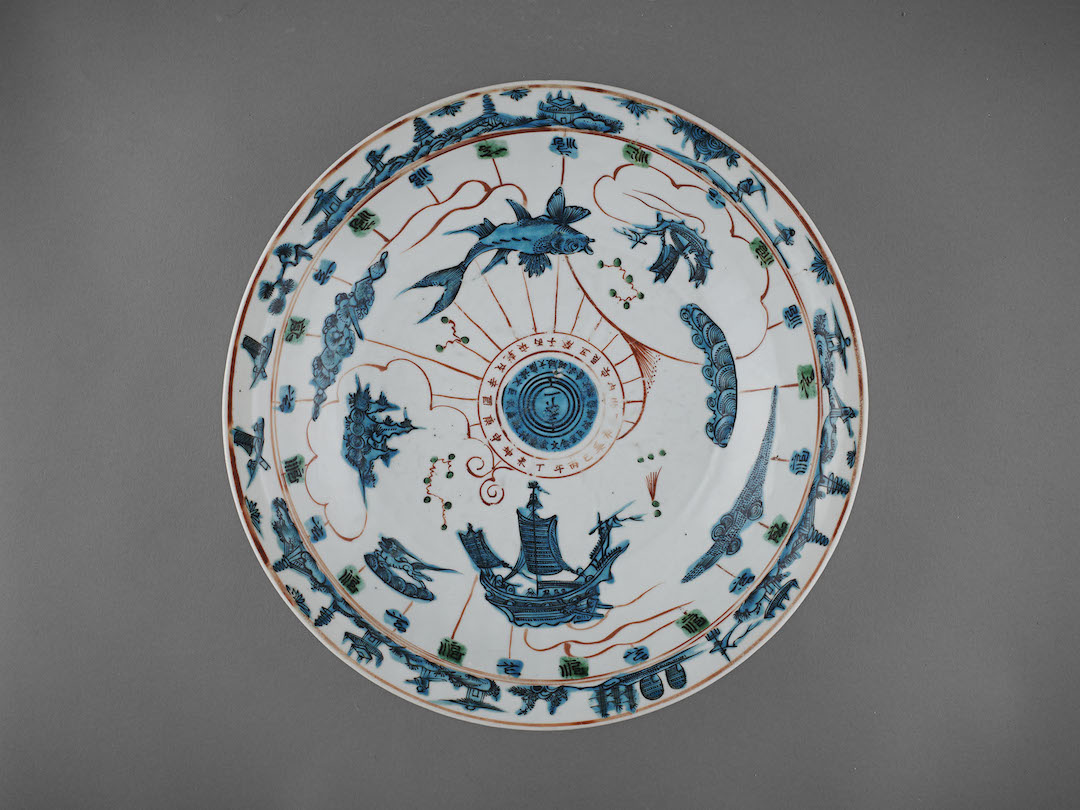
Zhangzhou Kiln Five Colored Compass Sailboat Pattern 1573-1620 Wanli Ming Dynasty Guimet Museum of Art, France
During the Longqing period (1567-1572), the Ming Dynasty lifted the maritime ban and opened Yuegang in Zhangzhou, Fujian Province as a port for foreign trade. Since then, merchants from Quanzhou and Zhangzhou have connected with the outside world through Yuegang. In addition to Jingdezhen blue and white porcelain, the ceramics that filled the ship's cabin also included some works produced at the mouth of local kilns, which were regarded as Shantou kilns by early academic circles. This view did not change until the 1980s, when archaeologists discovered kiln sites in Nansheng and Wuzhai, Zhangzhou, Fujian. Through the comparison of specimens and handed down artifacts, the academic community was finally able to confirm that the so-called Shantou kiln actually included some Zhangzhou kiln products. The large porcelain plate collected by the Guime Museum in France is a special style. As shown in the picture, the plate pattern is painted with overglaze fan red and peacock blue. In the center of the plate are the three characters "天一", surrounded by another double circle of characters. The inner circle contains the Nine Stars of the Big Dipper, while the outer circle consists of the heavenly stems, earthly branches and hexagrams of the Book of Changes. In addition to the inscription, there are also patterns of sailing ships, sea fish, waves, mountains and constellations. Since the same examples can also be found in museums in Japan and the Netherlands, especially those unearthed in Osaka Castle Town, they can also be combined with Japanese collections, indicating that after the mid-16th century, as East Asia integrated with the world, Zhangzhou kiln porcelain not only circulated in the adjacent sea areas, but also Sold as far as Europe.
It is worth noting that the inscription "天一" on the heart of the plate has the implication that the world is set in one direction. In this context, this type of porcelain plate may be regarded as a backup compass for sea navigation, as scholars have said. .
meet by chance
The vast and boundless ocean connects into a blue stage. Through repeated explorations by people from all walks of life, channels of contact and opportunities for encounters gradually extend. People from different corners of the world have unexpectedly written touching legends on their journeys towards the known and the unknown.

"Narcissus and Wintersweet Scroll" 16th century, Qiu Ying, Ming Dynasty, collected by the National Palace Museum, Taipei
The "Narcissus and Wintersweet Scroll" on display is the work of Qiu Ying in the Ming Dynasty. Qiu Ying (approximately 1494-1552), courtesy name Shifu and nickname Shizhou, was born in Taicang, Jiangsu Province. He was good at painting landscapes, figures, birds, animals, flowers, and borders. This painting is beautifully conceived, depicting narcissus standing side by side in the cold winter, with wax plums poking through it. It not only refers to the tradition that vanilla symbolizes a gentleman, but also has the connotation of the new year. The flowers have precise shapes, elegant postures, and fresh charm; the composition, outline, and color filling methods can be traced back to Ma Lin (1195-1264)'s "Layered Ice Silk" and other Southern Song Dynasty courtyard paintings, which are very different from the expressions of literati paintings. Such a style of exquisite depiction, bright and elegant, and workmanship made Qiu Ying the most famous professional painter in Suzhou in the 16th century. The abundance of fakes shows that Qiu Ying's paintings were widely welcomed by the art market, and also reflects the extreme taste of Suzhou at that time.
Despite this, there is still no data indicating that the Japanese envoys to the Ming Dynasty actively solicited Qiu Ying's paintings. This may be because his identity and painting style were classified as professional, which was different from the works of literati, so Qing Ming envoys did not make efforts to get in touch with him. It was not until the early seventeenth century that a large number of forgeries claiming to be a collaboration between Qiu Ying and Wen Zhengming (1470-1559) appeared, and the perspective of painting history changed.

A 16th-century tall bowl with gold and floral patterns on a blue and red ground. Collection of the National Palace Museum in Taipei.
The tall bowl is decorated with two glaze patterns on the inside and outside. The interior of the vessel is blue and white, as shown in the picture, with a diamond pattern under the mouth, a double circle at the bottom, and a bird on a broken branch inside. The outside of the vessel has alum red color as the background color and is decorated with gold foil florets. The combination of red and gold contrasts with the golden pattern, exuding a gorgeous texture like gold brocade. Therefore, since the 19th century, such works have gradually used the name "Golden Hand" given by Japanese academic circles and become popular all over the world.

Blue and white fountain pattern ewer, 1522-1566, Jiajing, Ming Dynasty, collected by Guimet Museum, France
The fountain decorated with blue and white pots is called "magic fountain". This type of holding pot is rarely handed down from generation to generation, and most of them have no dating date. However, because one of the pieces in the Singapore collection bears the date "Made in the Jiajing Year of the Ming Dynasty" (1522-1566), scholars have taken this as evidence and concluded that the "Magic Fountain" teapot handed down from ancient times is a product of the 16th century. Researchers believe that in addition to the identification, the water can also flow from the pear-shaped pot body and its hexagonal shape. Compared with another type of holding pot decorated with the coat of arms of the Pesoto family in Portugal, this product represents the Jiajing Year. System to confirm the academic inference.
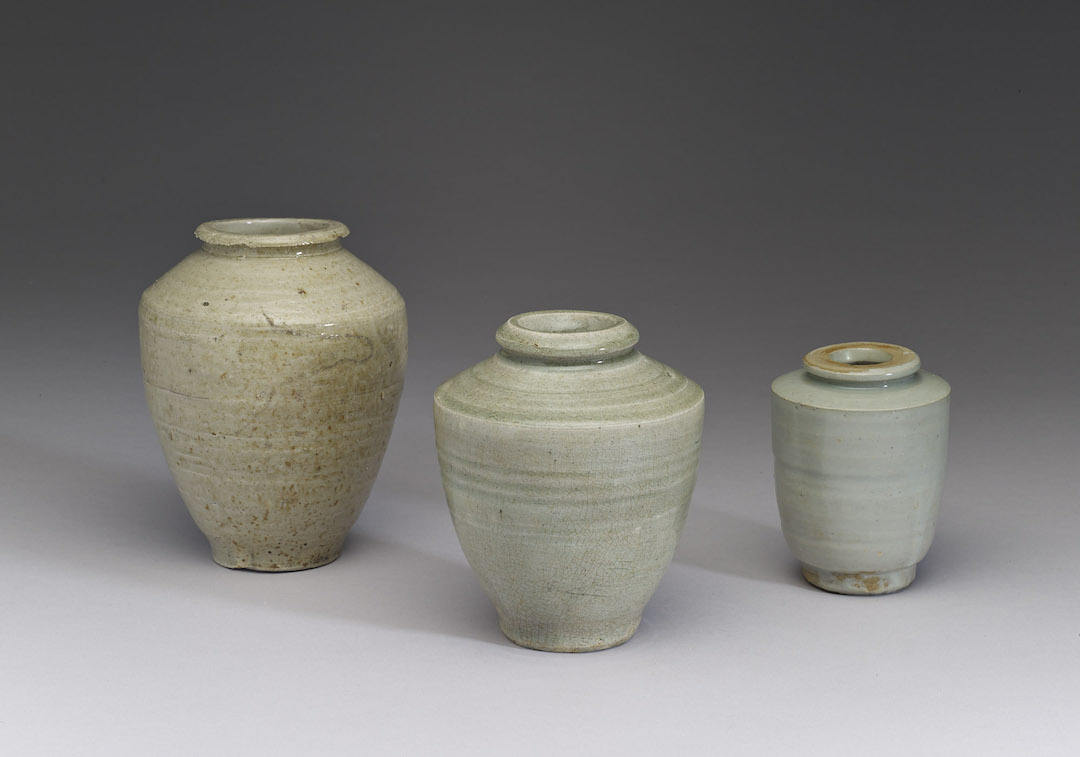
Anping teapot, 17th century, collected by the National Palace Museum, Taipei
Diversity and new look
With the advent of the sea era, countries such as Portugal, Spain, and the Netherlands in East Asia, West Asia, and Western Europe have actively or passively joined the ranks of exploring foreign lands. The interaction between multiple groups of people has also allowed for extensive exchanges of each other's art and culture. .
Through imitation, learning, and translation, artists and craftsmen reinterpret seemingly foreign resources; through misunderstanding and understanding, they create new knowledge that encompasses both east and west, and create a variety of wonderful works. These tangible and intangible assets present an unforgettable drama of gathering and exchange, and at the same time bear witness to the diverse new look of human civilization in this era.
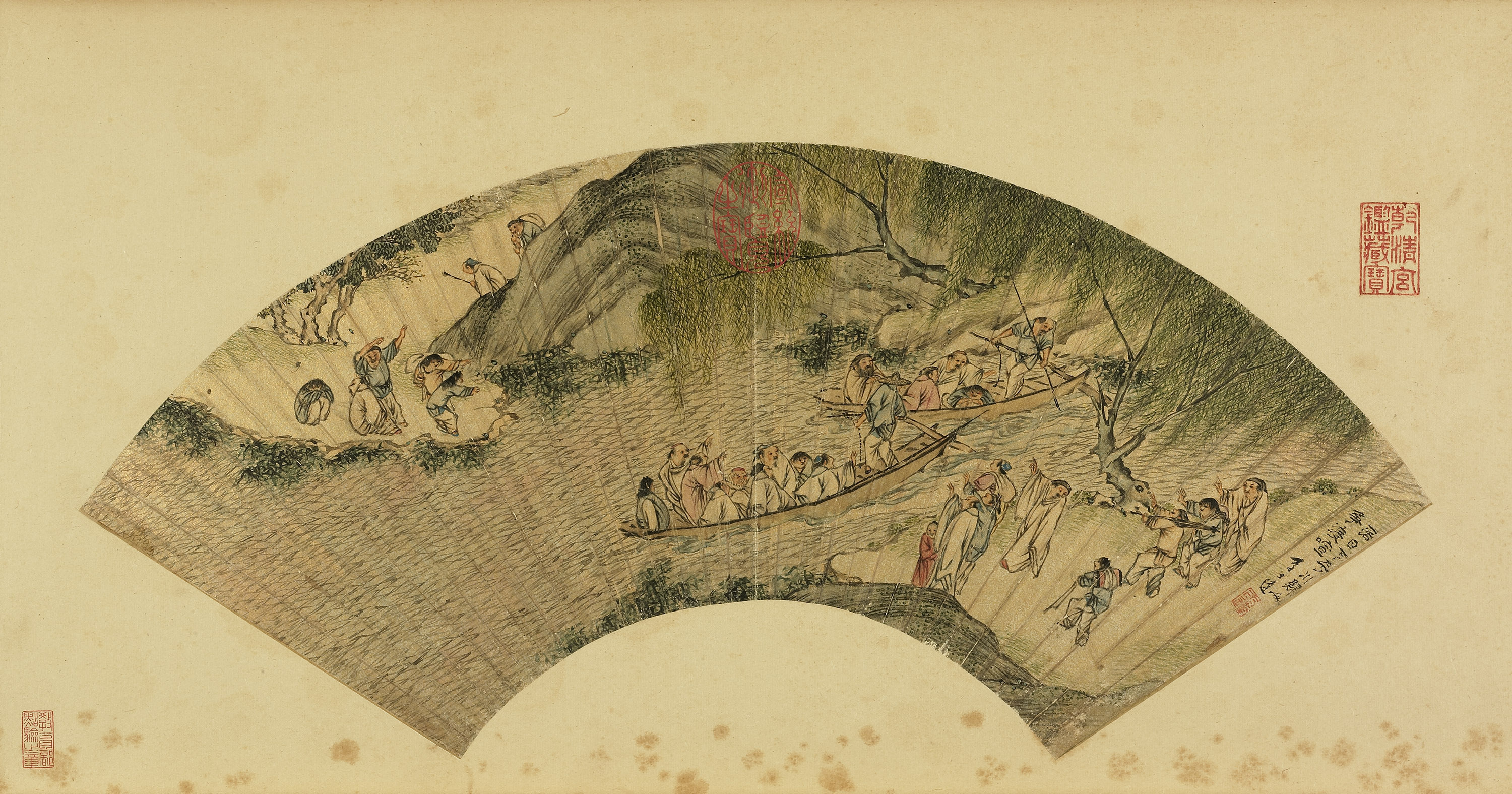
Pingchuan Returning Fan, 1368-1644, Li Shida, Ming Dynasty, collected by the National Palace Museum, Taipei
Since the mid-16th century, Chinese painters of various identities and sects have devoted themselves to the creation of folding fan paintings. As shown in the exhibition, painters took advantage of the folding fan's curved image and portability to create new compositions, content, and viewing methods, making folding fan paintings a new medium for fan owners to express their identity, aspirations, and aesthetics. Arouse the hobbies and pursuits of all strata of society.
Li Shida (active from the 16th to the 17th century) "Pingchuan Return" also imitates the combination of poetry, calligraphy and painting, but deliberately draws on colloquial verses, and uses the hustle and bustle of the crossing as the focus of the picture, reflecting the folding fan It has become widely popular, and professional painters cater to ordinary consumers and express the creative attitude of life interest.
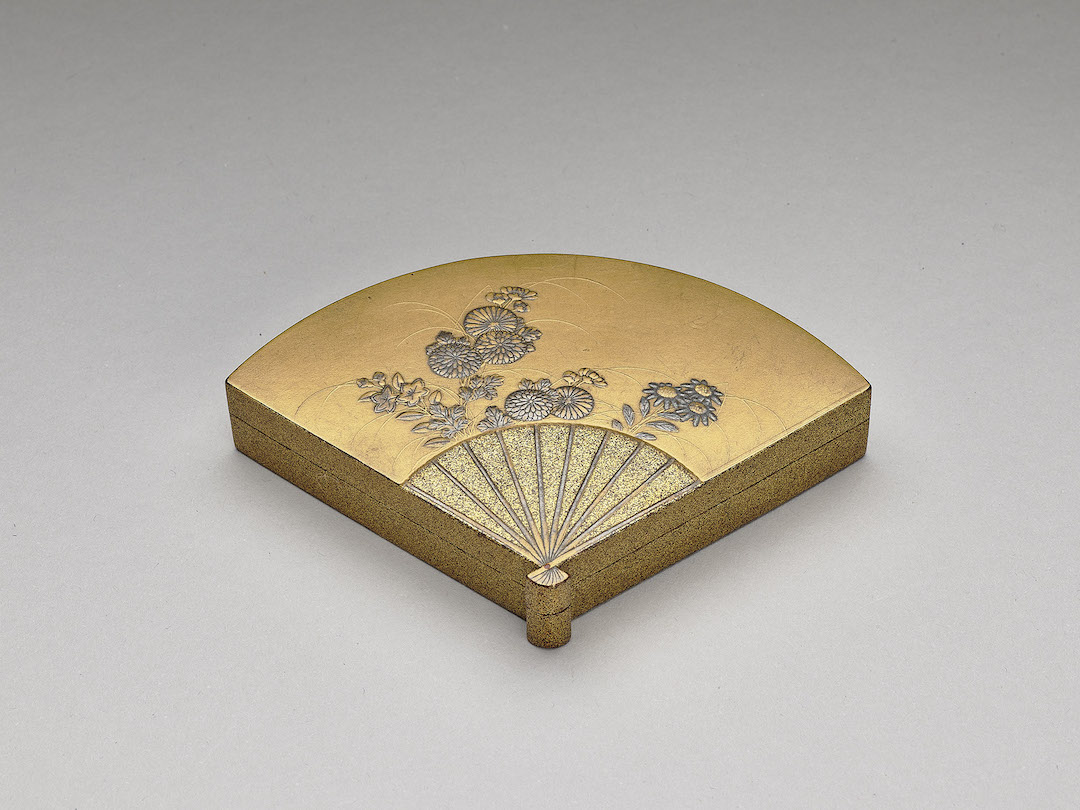
Japanese chrysanthemum painted fan box, 17th-18th century Collection of the National Palace Museum, Taipei
Among the two fan-shaped boxes on display, one of them imitates the surface of a folding fan. In addition to the clearly identifiable fan ribs, it is also made into a wavy curved surface and decorates the scenery of landscape pavilions. As for the box body, it is divided into upper and lower layers, with two small jade items placed separately. In the second fan-shaped box, the fan surface outside the fan ribs is kept flat, and the chrysanthemums and platycodons on the surface of the slightly convex surface are painted with Gaoshi-e technique. A piece of jade is also stored in the box. The two fan-shaped boxes are both from the Qing Dynasty imperial palace, and are separate storage boxes for storing small items. This type of storage of antiques in imported lacquer boxes can be compared with Wen Zhenheng's "Long Wu Zhi", which seems to show his emphasis on a kind of elegant taste between storage and display through selection.
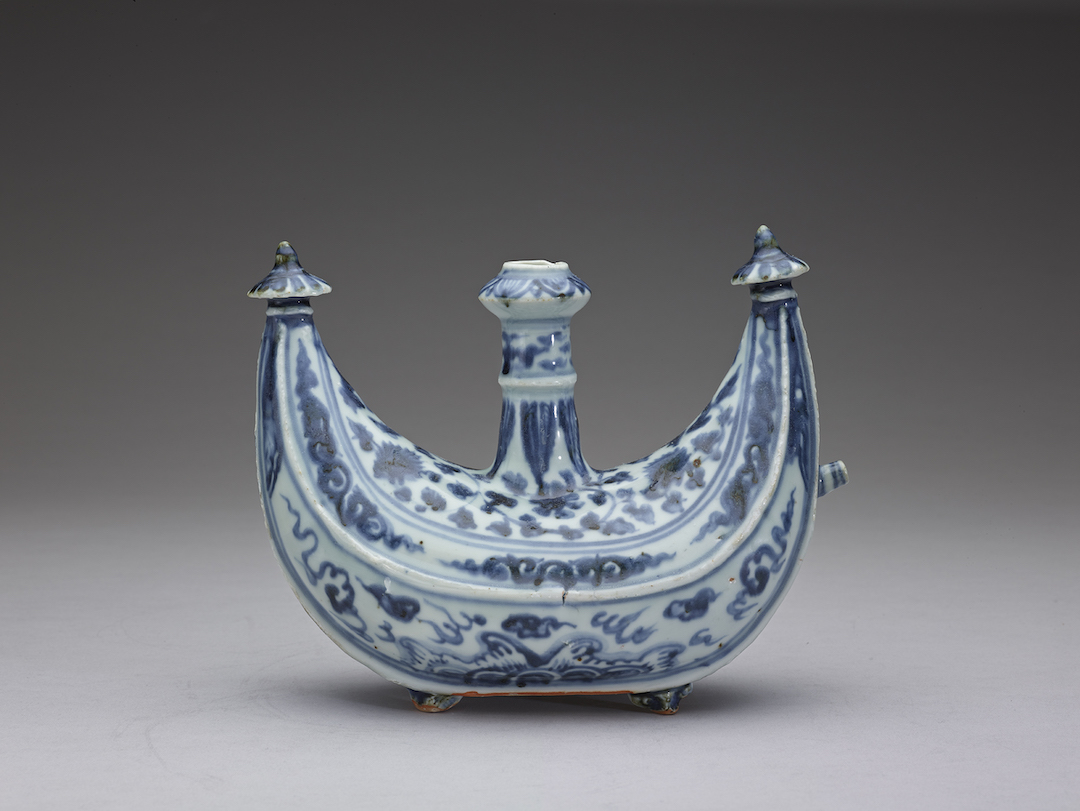
Blue and white crescent-shaped military holder, 16th century, Collection of the National Palace Museum, Taipei
This water vessel is shaped like a crescent moon. In Islamic teachings, the crescent moon symbolizes new energy. The Age of Discovery in the 16th century not only opened up new routes, but also brought more new elements for reference. As for the decorative pattern, since it is similar to the items found in the wreckage of the Lina, we can refer to the date of the sunken ship and regard it as a product from the late 15th century to the early 16th century. On the other hand, comparison with the seventeenth-century metal vessels in the Metropolitan Museum's collection also suggests that the crescent shape may have been imitated from the metal vessels. In addition to the crescent moon shape, a similar waxing moon was later combined with flowers and trees to form another moon shadow pattern. Take the exhibits in this exhibition as examples, whether they are unmarked examples from the mid-fifteenth century or porcelain bowls with the mark "Made in the Jiajing Year of the Ming Dynasty". In particular, specimens with crescent patterns have been unearthed from the Fustat site in Egypt. The site is located on the corridor between China and West Asia since the 15th and 16th centuries. It seems that some kind of porcelain can be observed from the porcelain gathered there. Special patterns produced specifically for the Islamic market.
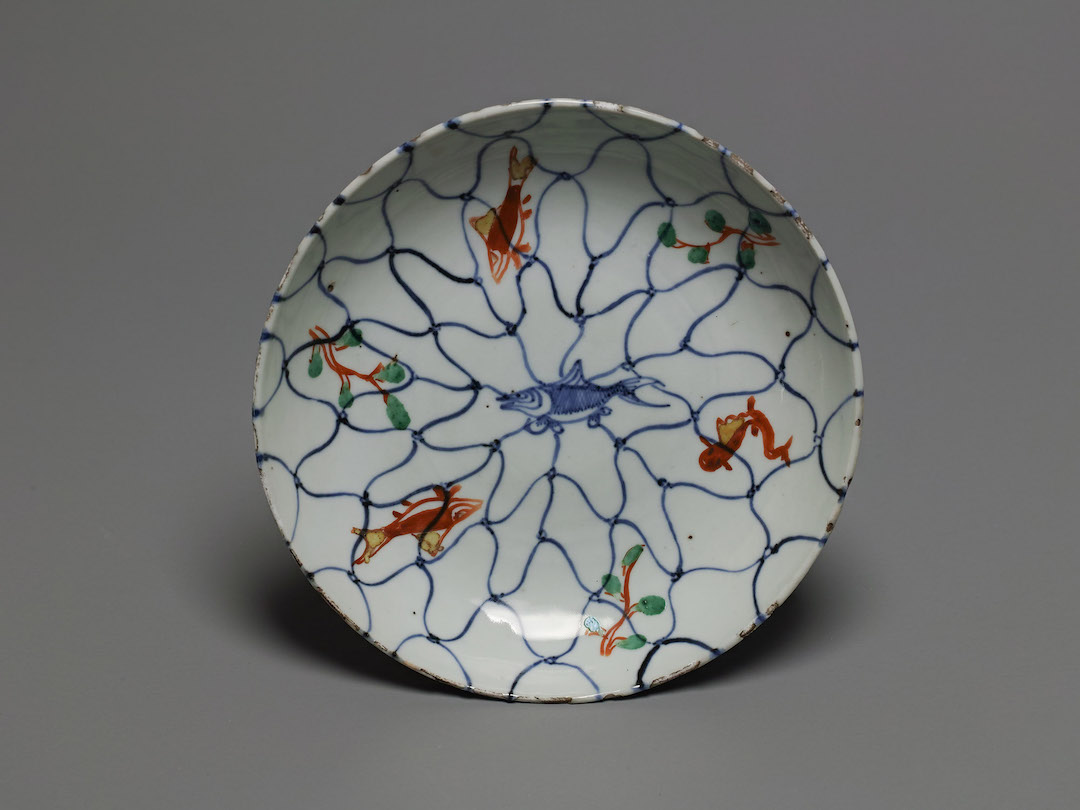
Colorful mesh fish and algae pattern plate 1621-1627 Tomorrow Kai Jingdezhen Kiln Tianqi red painting Collection of Osaka Municipal Museum of Oriental Ceramics
This type of porcelain was mainly produced in ancient dyeing during the Tianqi period. Some of the porcelains were decorated with colorful decorations and were called "Nanjing Chi-e" or "Apocalypse Chi-e" in Japan, and they were very popular. For a long time, scholars did not know where kilns in Jingdezhen were producing ancient dyes. It was only in recent years that ancient dyes similar to those handed down from Japan were discovered in Jingdezhen in recent years, and they gradually understood the manufacturing situation.
This exhibit is covered with blue and white mesh paintings. In the middle of the plate is a small blue and white fish also painted with blue paint, surrounded by three painted fish mainly painted in red, with red and green paint. The three lines of water plants are arranged staggeredly. The painter cleverly captures the contrasting image of "net and fish", leaving the viewer with space to imagine whether the fish is in the net or escaping from the net. There is also a mesh pattern on the bottom of the plate, the ring foot is flat and concave, and a ring-shaped exposed tire is formed around the ring foot.
The pattern given by ancient dyeing to Akiaki Akae became the model for Arita porcelain, the earliest porcelain in Japan in the 17th century, and also strongly influenced the porcelain of later generations. The mesh pattern is still a common tableware pattern in Japan today and has been integrated into the daily life of Japanese people. It can be seen from this that Furusuke is deeply loved by Japanese people and has become a part of Japanese culture.
(The pictures and text in this article are compiled from the official website of the National Palace Museum in Taipei)
